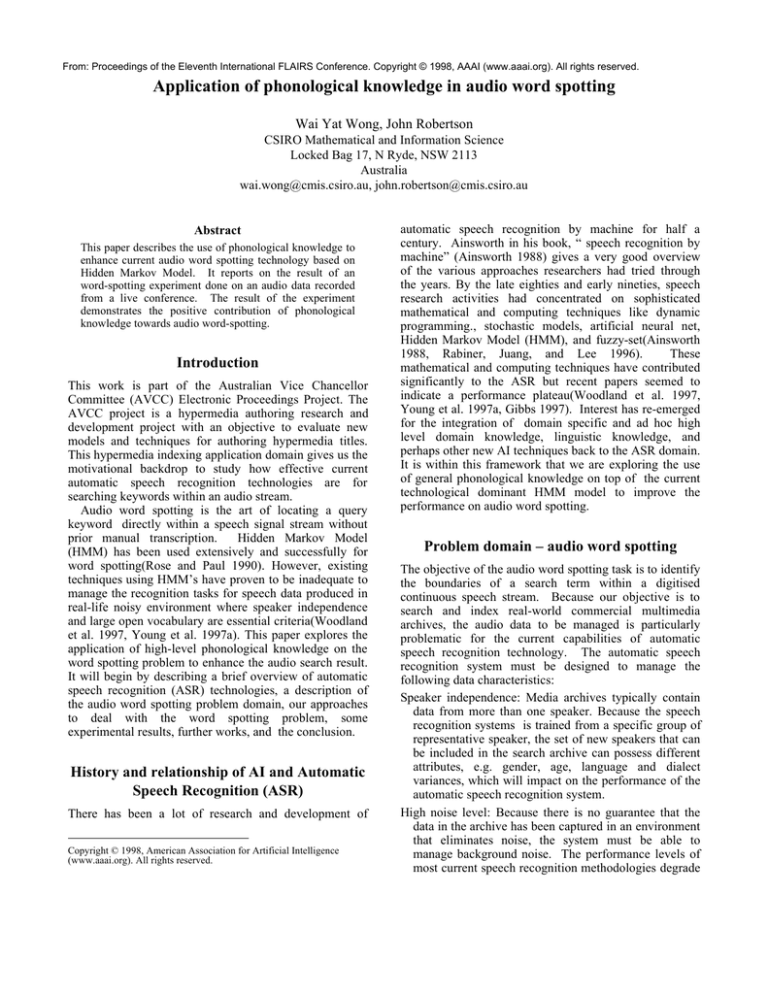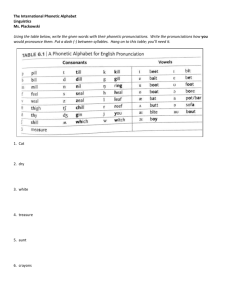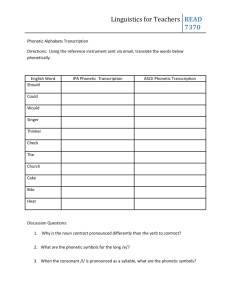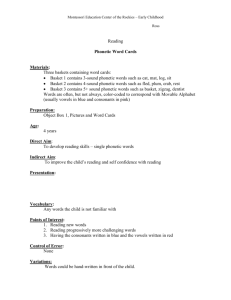
From: Proceedings of the Eleventh International FLAIRS Conference. Copyright © 1998, AAAI (www.aaai.org). All rights reserved.
Application of phonological knowledge in audio word spotting
Wai Yat Wong, John Robertson
CSIRO Mathematical and Information Science
Locked Bag 17, N Ryde, NSW 2113
Australia
wai.wong@cmis.csiro.au, john.robertson@cmis.csiro.au
Abstract
*
This paper describes the use of phonological knowledge to
enhance current audio word spotting technology based on
Hidden Markov Model. It reports on the result of an
word-spotting experiment done on an audio data recorded
from a live conference. The result of the experiment
demonstrates the positive contribution of phonological
knowledge towards audio word-spotting.
Introduction
This work is part of the Australian Vice Chancellor
Committee (AVCC) Electronic Proceedings Project. The
AVCC project is a hypermedia authoring research and
development project with an objective to evaluate new
models and techniques for authoring hypermedia titles.
This hypermedia indexing application domain gives us the
motivational backdrop to study how effective current
automatic speech recognition technologies are for
searching keywords within an audio stream.
Audio word spotting is the art of locating a query
keyword directly within a speech signal stream without
prior manual transcription.
Hidden Markov Model
(HMM) has been used extensively and successfully for
word spotting(Rose and Paul 1990). However, existing
techniques using HMM’s have proven to be inadequate to
manage the recognition tasks for speech data produced in
real-life noisy environment where speaker independence
and large open vocabulary are essential criteria(Woodland
et al. 1997, Young et al. 1997a). This paper explores the
application of high-level phonological knowledge on the
word spotting problem to enhance the audio search result.
It will begin by describing a brief overview of automatic
speech recognition (ASR) technologies, a description of
the audio word spotting problem domain, our approaches
to deal with the word spotting problem, some
experimental results, further works, and the conclusion.
History and relationship of AI and Automatic
Speech Recognition (ASR)
There has been a lot of research and development of
Copyright © 1998, American Association for Artificial Intelligence
(www.aaai.org). All rights reserved.
automatic speech recognition by machine for half a
century. Ainsworth in his book, “ speech recognition by
machine” (Ainsworth 1988) gives a very good overview
of the various approaches researchers had tried through
the years. By the late eighties and early nineties, speech
research activities had concentrated on sophisticated
mathematical and computing techniques like dynamic
programming., stochastic models, artificial neural net,
Hidden Markov Model (HMM), and fuzzy-set(Ainsworth
1988, Rabiner, Juang, and Lee 1996).
These
mathematical and computing techniques have contributed
significantly to the ASR but recent papers seemed to
indicate a performance plateau(Woodland et al. 1997,
Young et al. 1997a, Gibbs 1997). Interest has re-emerged
for the integration of domain specific and ad hoc high
level domain knowledge, linguistic knowledge, and
perhaps other new AI techniques back to the ASR domain.
It is within this framework that we are exploring the use
of general phonological knowledge on top of the current
technological dominant HMM model to improve the
performance on audio word spotting.
Problem domain – audio word spotting
The objective of the audio word spotting task is to identify
the boundaries of a search term within a digitised
continuous speech stream. Because our objective is to
search and index real-world commercial multimedia
archives, the audio data to be managed is particularly
problematic for the current capabilities of automatic
speech recognition technology. The automatic speech
recognition system must be designed to manage the
following data characteristics:
Speaker independence: Media archives typically contain
data from more than one speaker. Because the speech
recognition systems is trained from a specific group of
representative speaker, the set of new speakers that can
be included in the search archive can possess different
attributes, e.g. gender, age, language and dialect
variances, which will impact on the performance of the
automatic speech recognition system.
High noise level: Because there is no guarantee that the
data in the archive has been captured in an environment
that eliminates noise, the system must be able to
manage background noise. The performance levels of
most current speech recognition methodologies degrade
significantly when there is environmental noise. Our
experimental data was recorded in an auditorium with
background audience noise and additional noise from
the recording equipment.
Open vocabulary: We do not make any assumption on the
vocabulary of the query keyword term and the target
audio archive data for searching This is contrasted with
some speech recognition systems which requires that
the query keyword and the target audio archive data for
searching must be bounded by a controlled set of
vocabulary. Furthermore, we should be able to cater for
any query keyword that can be sufficiently represented
by an arbitrary combination of standard linguistic
phonetic set (e.g. International Phonetic Alphabet (IPA)
(Akmajian, Demmers, and Harnish 1987, Macquarie
1990 )) .
Continuous speech: The audio data will contain data
spoken in a normal conversational manner. This is
contrasted to a lot of studies where the speech
recognition is done on isolated word or finite set of
isolated phrases predefined and constrained by a
grammar.
Experimental approach
The underlying speech processing engine for our audio
word spotting exercise is based on the HTK toolkit(Young
et al. 1997b) from the Entropic Research Laboratory for
building hidden Markov Model based speech recognisers.
The process consists of three sequential phases: the
HMM training phase, the grammar specification phase,
and the recognition/word spotting stage. Figure 1 below
depicts the process.
For the training phase, we use an ANDOSL speech corpus
(Miller et al. 1994). This database contains a collection of
sentences spoken by Australians and has been previously
acoustic-phonetic-labelled. Acoustic-phonetic labelling
involves segmenting the speech signal in terms of
phonetic characteristics. In principle, segments which
have the same acoustic-phonetic characteristics are given
the same label, and each assigned label links the acousticphonetic segment to the phonetic entity it represents. The
set of labels associated with a speech signal file
constitutes a transcription and each transcription is stored
in a separate label file. In our experiments, continuous
speech data of 200 sentences from 4 different speakers
from the ANDOSL corpus were used as a training dataset.
The raw speech waveform for training is parameterized
into speech vectors. Based on the standard DARPA
TIMIT Acoustic-Phonetic continuous Speech Corpus
phone set(Lamel, Kassel, and Seneff 1996) and the
International Phonetic Alphabet (Macquarie 1990), we
derive a reduced set of 45 phones (figure 2) and build a
HMM for each phone; the 45 HMM’s include a silence
and pause model. Together with a prototype HMM
definition, the speech vectors and labels are fed into a
training phase to estimate the parameters for the HMM’s.
The algorithms used in the training phase are the BaumWelch re-estimation and the forward-backward
algorithm(Young et al. 1997b). The output of this
training phase is the required set of HMM phone models
used for the word spotting exercise.
Speech data for training
Speech Waveform
Baum-Welch algorithm for
building and training the HMM’s
Speech Vectors
Prototype HMM Def
Linguistic
Phonological rules
HMM training phase: building required HMM
via training
HMM training phase
Fully trained HMM’s
Network file for grammar
specification
Extended Phonetic
representation and phonetic
complement construction
Standard Phonetic
Query
Representation from Dictionary
keyword
Grammar Specification phase
Label files
Viterbi algorithm using the
token passing model for
recognition process
Location of
keyword
Speech vectors
Speech Waveform to be word spotted
Recognition /word spotting phase
Figure 1: The Experimental Process
Phone groups
Stops(Plosives)
A/Fricatives
Nasals
Approximants
(Semivowels)
Short vowels
Long vowels
Diphthongs
Other
Phones
p, t, k, b, d, g
T, D, f, h, v, s, z, S, Z
m, n, N
w, l, r, j
V, E, A, I, O, U, @
a: , e: , i: , o: , u: , @:
ei, @u, oi, ai, au, I@, u@
H#, #, J
figure 2: phone set
Gramar Specification Phase : building the
grammar necessary for word spotting
The query keyword is mapped to a standard phonetic
grammar representation string using a standard phonetic
dictionary (Macquarie 1990). The resultant phonetic
representation is extended using phonological knowledge
from the linguistic research to allow for other possible
variant pronunciation under general context. The grammar
for the anti-phonetic pattern which forms the complement
of the extended phonetic representation string for the
query keyword is also constructed. Both the grammars for
the phonetic string of the query keyword and its
complementary anti-phonetic pattern, are fed into the
grammar specification network file.
This section illustrates an example with the query
keyword “library”. Using standard phonetic dictionary, a
query keyword like “library” would be converted to a
phonetic stream like /l ai b r @ r i/ using a standard
Australian phonetic dictionary.
Applying the
phonological rules, the phonetic stream is then extended
to be / (r|l) (@|ai) (v|b) [r] @ r (i | I)/. The grammar for
the phonetic complements of the keyword is also
constructed by the anti-word grammar generation module.
The combination of the valid phonetic grammar
representations of the keyword and the corresponding
grammar for the phonetic complements will produce
grammar specification network as shown below:
/* | = or, [ ] = optional, concatenation = and,
compl. = complement */
$LIBRARY = WD_BEGIN% LIBRARY (r|l) (@|ai) (v|b)
[r] [@] (r|l) (i:|I) WD_END% LIBRARY;
$ff1 = f | h | v | T | D | s | S | z | Z;
$ff1v = f | h | T | D | s | S | z | Z; /* Fricatives & compl. */
$pp1 = p | t | k | b | d | g;
$pp1v = p | t | k | d | g; /*plosive & compl.*/
$nn1 = m | n | N; /* nasal & compl.*/
$vv1 = V | E | I | O | U | @ | A | a: | e: | i: | o: | u: | @: | ei
| @u | oi | ai | au | i@ | u@;
$vv2 = V | E | I | O | U | A | a: | e: | i: | o: | u: | @: | ei |
@u | oi | au | i@ | u@;/* vowel & diphthongs & compl */
$vv3 = V | E | I | O | U | A | a: | e: | i: | o: | u: | @: | ei |
@u | oi | ai | au | i@ | u@;
$vv4 = V | E | O | U | @ | A | a: | e: | o: | u: | @: | ei | @u
| oi | ai | au | i@ | u@;
$aa1 = w | l | r | j;$aa2 = w | j; /* semivowel & compl. */
$oo1 = H# | # | J;
$g0 = $aa2 | $pp1 | $nn1 | $oo1 | $ff1;
$g1 = $ff1v | $pp1v | $nn1 | $oo1 | $aa1;
$Garbage = WD_BEGIN% Garbage $g0 $vv2 $g1 $vv3
$g0 $vv4 WD_END% Garbage;
( <$LIBRARY |$Garbage> )
Here is a brief explanation of how phonological
knowledge can be used during the grammar network
specification stage.
Phonological rules express the
systematic ways in which the pronunciation of words or
phones may change with their environment. For example,
vowel reduction is something common in casual spoken
English. The word “potato”, if pronounced slowly, will
have this phonetic representation /p @ t ei t @u/. But in
continuous casual speech, the first vowel, @, can
sometimes be elided. Thus, the phonetic representation
of “potato” could become /p t ei t @u/(Hawkins 1984).
So the phonological rule can produce an extended
phonetic representation for “potato” to be /p [@] t ei t
@u/ (where [ ] means ‘optional’).
Similarly, in
continuous speech, there is the phenomenon of consonant
deletion, e.g., the sequence “six seven” is normally
pronouced as /s I k s E v n/ or /s I s E v n/ instead of /s I k
s s E v n/ (Ainsworth 1988); or, the dropping of
consonant h in the sequence “twist his arm” to produce /t
w I s t I z a: m/ instead of /t w I s t h I z a: m/(Hawkins
1984).
Their extended phonetic representation will
respectively be /s I [k] s [s] E v n/ and /t w I s t [h] I z a:
m/. There is also Sandhi consonant insertion(Ainsworth
1988); the word “how” is pronounced as /h au/ and “are”
is pronounced /a:/, but “how are you?” is pronounced as /h
au w a: j u:/ with a phone /w/ is inserted in between. The
extended phonetic representation for the query keyword
“how are you” can thus become / h au [w] a: j u:/. Other
rules include the possible substitution of accented vowel
with reduced vowel /@/ (schwa) (Akmajian, Demmers,
and Harnish 1987). For example, /E/ in “democrat” /d E
m O k r A t I v/ is sometimes substituted with a reduced
vowel /@/in “democracy” /d @ m O k r @ s i: /. Thus to
be inclusive, the extended phonetic representation can be
represented as /d (E/@) m O k r A t I v/ for the query
keyword “democrat”( where | means ‘either or’).
Phonological rules may also be expanded to capture
different ethnic background; for example, the word
“three” with the phonetic representation of /T r i / can be
often mispronounced as /t r i/ by a certain group of
people. Again, in this case, the phonological module will
produce an extended phonetic representation of /(T|t) r i/.
Recognition /word spotting phase: labelling test
speech data as word and anti word pattern
For the recognition/word spotting phase, the speech
archive which forms the target space for searching is
digitised and parameterised to speech vectors. The speech
vectors will be input to a Viterbi module toolkit(Young et
al. 1997b) which uses the previously trained HMM’s and
the grammar specification network file to produce a
resultant transcribed output. The Viterbi module makes
use of the Viterbi algorithm with token passing. The
resultant transcribed output will consists of locations of
the query keyword and locations of the anti-keyword.
Below is a sample of the transcribed output from word
spotting . The query keyword is “library”. The number to
the left is the end-time in second when the word label on
the right has been spoken. The starting time of the label
is taken to be the end-time of the previous label and 0
initially. Note that the output will contain either the
keyword or the “anti-keyword” – Garbage word.
#
0.130000 121 LIBRARY
0.530000 121 Garbage
0.920000 121 LIBRARY
2.760000 121 Garbage
3.460000 121 Garbage
4.500000 121 Garbage
4.970000 121 Garbage
5.520000 121 Garbage
5.920000 121 Garbage
6.660000 121 Garbage
6.920000 121 Garbage
8.120000 121 Garbage
8.510000 121 Garbage
8.680000 121 LIBRARY
9.180000 121 Garbage
……….
Result and analysis
One of the popular performance measurement in speech
community has been Figure of Merit(FOM) and the
Receiver Operation Curve(ROC) (Young et al. 1997b).
Since we believe that word spotting is more akin to
information retrieval and the metrics used in information
retrieval is intuitive and easily understood, we have
dropped the complex FOM and ROC metrics and have
opted for the metrics used in information retrieval
community – recall and precision (Salton 1989).
retrieved phrase of “electronic communication”. We are
working on a satisfactory metric to accommodate partial
match. Meanwhile, we do not count these partial matches
as retrieved relevant phrases.
Below are two tables which record the recall and
precision for some of the query phrases that we have used
in the experiment. The result of the first table is produced
without any use of phonological knowledge. The result of
the second table is produced with extending the grammar
using the phonological rules.
Without any use of phonological knowledge
Query keyword
Recall
Precision
8/8
8/9
“electronic publishing”
0/3
0/1
“Australia”
0/5
0/0
“library”
0/4
0/0
“today”
With the use of phonological knowledge
Query keyword
Recall Precision
8/10
“electronic publishing” 8/8
3/3
3/50
“Australia”
3/5
3/15
“library”
3/4
3/21
“today”
The result seems to indicate that the expansion of the
query keyword using phonological knowledge improves
the performance of word spotting both in recall and
precision.
In view of the requirement that the
environment could be noisy and the speech data can come
from any speaker with an open vocabulary,
the
improvement is not surprising. The additional variant
phonetic representation of the query keyword using the
phonological rule will capture some of the possible ways
the keyword is spoken by a general speaker and is
perturbed by noise.
It is interesting to note that if the performance without
phonological knowledge is reasonable as in the case for
query keyword “electronic publishing”, the use of
phonological knowledge to extend the query keyword
phonetic representation actually produce a worse
precision value. Again, this is expected, the word spotter
retrieves more than necessary.
recall = (number of retrieved relevant phrases via
word spotting) / (total number of relevant
phrases in the original audio stream)
precision = (number of retrieved relevant phrases via
word spotting) / (total number of retrieved
phrases via word spotting)
Using more sophisticated HMM’s
Regardless of which performance measurement used,
one interesting behaviour is observed. In quite a few
occasions the word spotting produces instances of
retrieved phrase which appear wrong because the target
query key-phrase does not show up in the same location
on the search archive, but on closer examination, the
retrieved phrases are in fact partial match – hence they are
retrieved during the word spotting process. Examples :
query string of “electronic publishing” versus the
Our HMM’s are trained using a small training dataset of
eight hundred sentences from four individual speakers.
Entropic Laboratory has some commercial pre-trained
HMM’s (Power et al. 1997) for speech recognition which
use highly sophisticated HMM architectures & language
models. These HMM’s are also trained from very large
dataset from large number of speakers and with very large
vocabulary. We will conduct the same experiment using
those HMM’s. We expect the same positive contribution
Further work
from the application of phonological knowledge.
Better phonetic complement grammar model and
approximate pattern matching approach
In the word & anti-word grammar model, the word
spotting system has to construct all valid variant phonetic
representations for the keyword ( set P) and their phonetic
complements (set P-1 ). The construction of the phonetic
complements to the query keyword can be delicate. So
far we have tried constructing the grammar for the
keyword phonetic complements to be all possible phonetic
combination minus the possible phonetic representation of
the keyword.—the full complement method. We have
also tried constructing the grammar for the keyword
phonetic complements to be all possible combination of
complement phones to the syllable level – the syllable
complement method. The full complement has not
produced a good result because of the noisy phonetic
recognition. But the syllable complement has done better.
The upshot of this is that we find this word and anti-word
grammar model not as easy to use as we have hoped for.
We are also exploring the approximate pattern
matching approach. In this approach, the audio stream is
first recognised by our HMM’s into a complete
continuous phonetic stream. We assume this resultant
phonetic stream to be error prone. We then use an
approximate pattern-matching technique which is
extended from “agrep”(Dept. of Computer Science,
University of Arizona) to see if we can extract the
phonetic representation of the query keyword from the
phonetic stream. A confusion matrix produced from the
HTK toolkit, which contains probabilities of one phone
being confused with another, is being used together with
phonological knowledge to reduce the search space.
Extend and complete the known linguistic
phonological rules
We are collaborating with linguists to capture linguistic
phonological rules into a complete phonological knowledge module and to develop a good algorithm for the
rule application. Other useful linguistic knowledge which
includes the study of stress patterns will also complement
the phonological knowledge. Concepts from natural
language processing can also be used to add new syntactic
& lexical constraints and other semantic constraints.
Conclusion
The integration of AI based techniques with high-level
linguistic knowledge on top of the current HMM based
speech signal processing engine can bring about realistic
ASR performance. The authors are exploring other
alternative AI based techniques which can make effective
use of the current pool of linguistic knowledge to achieve
reasonable result for audio word spotting.
References
(Ainsworth 1988)Ainsworth, W. A. 1988. Speech
Recognition by Machine. Peter Peregrinus Ltd. London,
United Kingdom.
(Akmajian, Demmers, and Harnish 1987)Akmajian, A.;
Demers, R. A.; and Harnish, R M. 1987 Linguistics: An
Introduction to Language and Communication. 2nd ed.,
MIT Press.
(Gibbs 1997)Gibbs, W. W. 1997. Taking Computers to
Task. Scientific American, July 1997, PP82-89.
(Hawkins 1984)Hawkins P. 1984. Introducing phonology.
Hutchinson, London.
(Lamel, Kassel, and Seneff 1996)Lamel, L. F.; Kassel, R.
H.; and Seneff, S. 1996. Speech Database Development:
Design and Analysis of Acoustic Phonetic Corpus. In
Proceeding of DARPA Universal Speech Recognition
Workshop (editors Baumann, L.S.), PP100-109.
(Macquarie
1990)Macquarie
Dictionary
Editorial
Committee 1990. The Macquarie Encyclopedic
Dictionary. The Macquarie Library Pty Ltd.
(Miller et al. 1994)Miller, B.; Vonwiller, J.; Harrington,
J.; and Dermody, P. 1994. The Australian National
Database of Spoken Language. In ICASSP94.
(Power et al. 1997)Power, K.; Matheson, C.; Ollason, D.;
and Morton, R. 1997. The graphHvite book. Entropic
Cambridge Research Laboratory Ltd, Cambridge
University.
(Rabiner, Juang, and Lee 1996)Rabiner, L.R; Juang, B. H.; and Lee, C. -H. 1996. An Overview of Automatic
speech Recognition. In Automatic Speech and speaker
Recognition: Advanced Topics (editors Lee, C.-H., Soong,
F.K., and Paliwal, K.K.) Kluwer Academic Publishers.
(Rose and Paul 1990)Rose, R. C. and Paul, D.B., 1990. A
hidden Markov model based keyword recognition
systems. In Proc. Int. conf. on acoust., Speech and Sig.
Processing, Apr 1990.
(Salton 1989)Salton, G. 1989. Automatic Text Processing,
The Transformation, Analysis, and Retrieval of
Information by Computer. Addison-Wesley Publishing
Company.
(Woodland et al. 1997)Woodland, P.; Gales, M.; Pye, D.;
and Young S. 1997. Broadcast News Transcription using
HTK. In ICASSP97, PP719-722
(Young et al. 1997a)Young, S.; Brown, M.; Foote, J.;
Jones, G.; and Jones, K. 1997. Acoustic Indexing for
Multimedia Retrieval and Browsing, In ICASSP97,
PP199-202.
(Young et al. 1997b)Young, S.; Odell, J.; Ollason, D.;,
Valtchev, V.; and Woodland, P. 1997b. The HTK Book.
Entropic Cambridge Research Laboratory Ltd, Cambridge
University.








